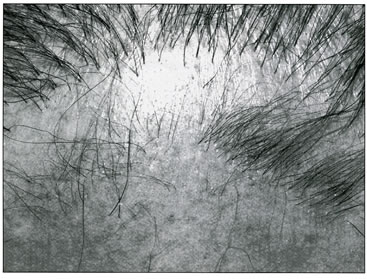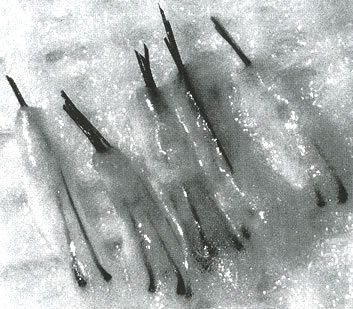by O’Tar T. Norwood, MD, Oklahoma City, Oklahoma, USA
Hair Transplant Forum International (July/August 1997 issue)
NOTES FROM THE EDITOR EMERITUS
 The evolution of “follicular transplantation” can be attributed to three people. Dr. Robert Bernstein coined the phrase and advanced the concept. Dr. Bob Limmer ((Limmer B: Forum, Vol. 2, #2, 1991.)), ((Limmer B: J Dermatol Surg Oncol, 1994; 20:789-793.)) introduced the use of the binocular microscope, providing the technology, and Dr. David Seager showed by direct hair counts, comparing the growth of grafts cut with and without the microscope, how the hair growth was improved when the follicular unit was kept intact. ((4th Annual Meeting of the International Society of Hair Restoration Surgery September 19, 1996, “Does the size of the graft matter?”)), ((Seager, DJ: Micrograft size and subsequent survival — accepted for publication — Journal of Dermatologic Surgery.))
The evolution of “follicular transplantation” can be attributed to three people. Dr. Robert Bernstein coined the phrase and advanced the concept. Dr. Bob Limmer ((Limmer B: Forum, Vol. 2, #2, 1991.)), ((Limmer B: J Dermatol Surg Oncol, 1994; 20:789-793.)) introduced the use of the binocular microscope, providing the technology, and Dr. David Seager showed by direct hair counts, comparing the growth of grafts cut with and without the microscope, how the hair growth was improved when the follicular unit was kept intact. ((4th Annual Meeting of the International Society of Hair Restoration Surgery September 19, 1996, “Does the size of the graft matter?”)), ((Seager, DJ: Micrograft size and subsequent survival — accepted for publication — Journal of Dermatologic Surgery.))
“What then is follicular transplantation?” I quote Dr. Robert Bernstein because he states it so completely and succinctly in his 1995 article “Follicular Transplantation:”
“Follicular Transplantation is the logical end point of over thirty years of evolution in hair restoration surgery beginning with the traditional large plugs and culminating in the movement of one, two and three hair units, which mirror the way hair grows in nature. The key to follicular transplantation is to identify the patient’s natural hair groupings, dissect the follicular units from the surrounding skin and place these units in the recipient site in a density and distribution appropriate for a mature individual. The critical elements of follicular transplantation are an accurate estimation of the donor supply of hair, meticulous dissection of the follicular units, and careful design of the recipient area to maximize the cosmetic impact of the transplant, use of large numbers of implants in fewer rather than more sessions, a long-term master plan that accounts for the progression of male pattern alopecia, and realistic expectations on the part of the patient.” ((Bernstein, RM: Follicular Transplantation. Int J of Aesthetic and Restoration Surg. 1994 Vol.3 #2 pp 119-132.))
By combining the concept of follicular transplantation with the use of the binocular microscope, hair transplant surgery has reached a new level of excellence.

Note, however, the grafts at the top of photo done several years earlier. They contain 4-5 hairs but more importantly they don’t look nearly as natural as the ones where follicular units were specifically kept intact.

Follow-Up
I am beginning to see my first patients back since I began follicular transplantation using the binocular microscope. Growth is better, particularly in single hair grafts which is exactly what I was told would happen. I have seen about ten patients, and every one of them is growing earlier and better.
X-factor
I refer to Dr. Jose Greco’s article in the last Forum about X-factor. I have had patients similar to his that grew only about 10% of the hair and I had repeated it usually at no charge and was very careful and still got poor growth. I have one of those patients now that wants some more grafts and I am going to do follicular transplantation and maybe in another four months we will know the answer.
Postoperative Ointment
Also in the last Forum, an article by Dr. Bernstein on ointment following hair transplants. Over the years I have gotten to where I did not use any ointment but there is a lot of evidence in the dermatology literature encouraging the use of post-op ointment. Ointments appear to speed up the healing process. I asked Dr, Blaine Lehr, my associate, to comment on this and he gave me the following statement “Postoperative ointment maintains moist wounds and increased surface humidity, which greatly increases the rate of re-epithelization. By decreasing crust formation, migrating epithelial cells do not face a barrier to their movement. With improved healing there is less potential for scarring and residual pigmentary abnormalities.”
Since I have been using ointment, patients look much better sooner. Sometimes there are hardly any crusts.
Why does it take so long?
Also in the last issue, Dr. Shiell commented on how it is interesting to read old Forums and specifically mentioned Bob Limmer’s use of the dissection microscope. Since I had not read the last issue of the Forum, I called Bob Limmer to get the first reference on the binocular microscope, and he said it was probably the one mentioned in the last Forum by Richard Shiell in his Editor’s Notes. What a coincidence!
I wonder why it took us so long to recognize how important that work was. I also wonder why it took us so long to recognize follicular bundles as the most logical unit for hair transplanting.
Related Posts:
- Innovations In Robotic Hair Restoration
- Advances in Robotic FUE
- Commentary on Redefining the “E” in FUE: Excision = Incision + Extraction
- What’s New in Robotic Hair Transplantation
- A New Device for Efficient Strip Harvesting
Rating:
Tags: Dr. O'tar Norwood, Dr. Robert M. Bernstein, Follicular Unit Transplant, FUT Posted by




